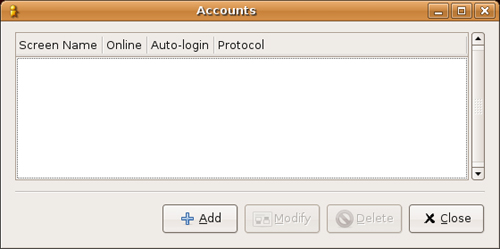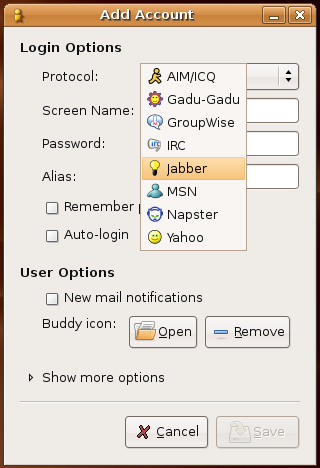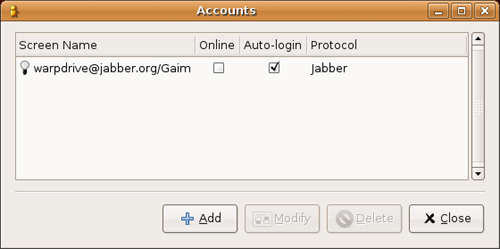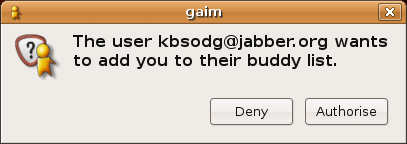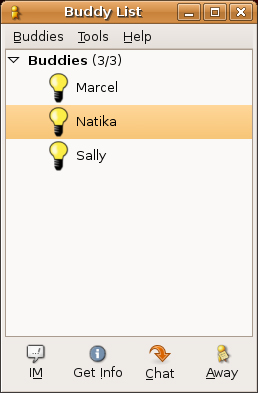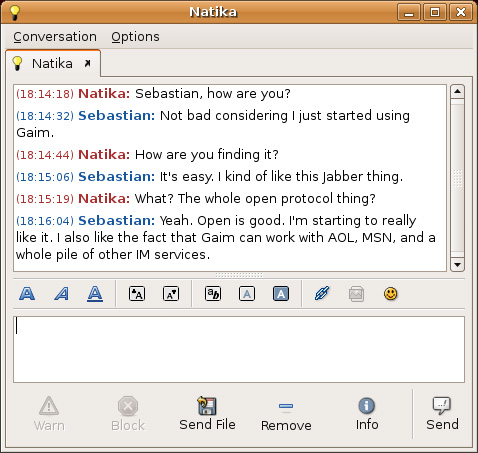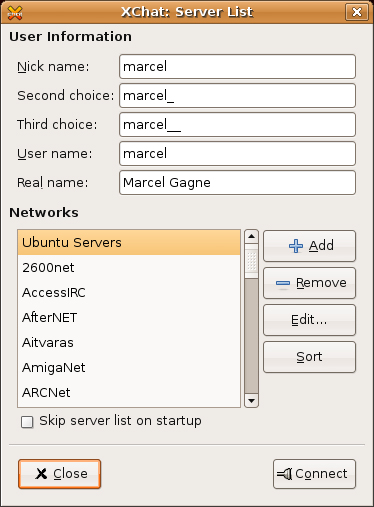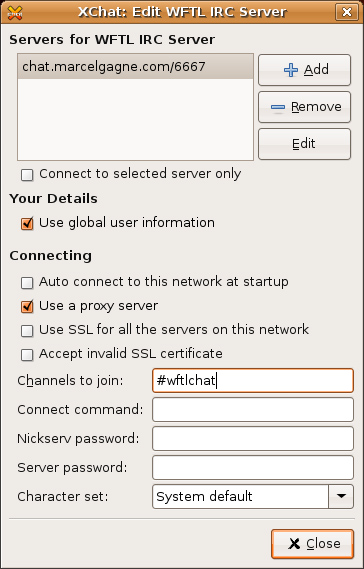Chapter 9 Instant Messaging, and IRC, Too!
Words, words, words . . . and then a whole lot more words, all of them flowing from one person to another. Whatever cool content exists on the world’s Web sites, the Internet is still all about communication.
These days, a new kind of communication has evolved—I call it mini-email. The one-liner. The short and sweet message. The instant message. The Net-connected society has grown to love those quick, always-on means of sending each other information. My own parents (who live in another province) send me a daily one-line weather report via their Jabber instant messaging client. If you are coming from the Windows world, there’s a good chance you already have one of these accounts, either with Yahoo!, AOL, MSN, or Jabber.
Because Jabber is an open protocol, it doesn’t belong to anyone in particular, so there is no single company driving its destiny (although there are companies using Jabber). Jabber uses a decentralized approach, so the system is more robust. In fact, anyone can run a Jabber server if he wants to. This is a boon to companies that may want to run a private, secure instant messaging network.
![]() Trivia Time Google Talk, an increasingly popular instant messaging service, uses the Jabber protocol.
Trivia Time Google Talk, an increasingly popular instant messaging service, uses the Jabber protocol.
Whether you choose to run Jabber, Yahoo!, MSN, or something else, the ideal instant messaging client is a multiprotocol client, one that lets you talk to all these services without having to run a client for Jabber, one for AOL, one for Yahoo!, one for . . . well, you get the idea. In this chapter, I’m going to cover two superb Linux instant messaging clients. One is a great multiprotocol client that handles all your favorite chat services. The second is a powerful IRC client.
What’s IRC, you ask? IRC is Internet Relay Chat, and next to your telephone, it is possibly the greatest real-time communication system in the world. I’ll tell you all about it shortly.
Gaim is one of the best multiprotocol instant messaging systems out there, period. Furthermore, this is one you can share with the people you know who are still running that other operating system. This is one favor they will thank you for. With Gaim, they no longer need a client for Yahoo!, another for MSN, and yet another for AOL because Gaim (gaim.sourceforge.net) is available for Windows as well. It even looks and works the same under both operating systems.
To start Gaim, look under the Applications menu, and then select Internet. You’ll see an entry there for Gaim Internet Messenger. The actual command name is gaim, in case you would rather start it from the shell or via the <Alt+F2> run program dialog.
The first time you start up Gaim, you get a simple window with text fields for Account (sometimes known as a Screen Name) and Password (see Figure 9-1). The Account field is blank, letting you know that you don’t have any accounts set up. Obviously, before we start using instant messaging through Gaim, we are going to need at least one account.
Look below the text fields and you see three buttons labeled Accounts, Preferences, and Sign on. Click the Accounts button and the Accounts window appears (see Figure 9-2). At this stage of the game, there is nothing in it.
Click Add, and the Add Account window appears. At the top of that window, you should see a drop-down list labeled Protocol. By default, it says AIM/ICQ. Click the button labeled Protocol and you see a number of possibilities including AIM/ICQ, Gadu-Gadu, GroupWise, IRC, Jabber, MSN, Napster, and Yahoo (see Figure 9-3).
Select Jabber from the list and watch as the window changes from AIM/ICQ to reflect the requirements of setting up a Jabber account (see Figure 9-4).
Enter your Screen Name (this doesn’t have to be your real name), Password (don’t use an important password), and Alias. To get a free account with jabber.org, you can leave the Server name as is. The Resource name can also be safely left as Gaim. Unless you want to be asked for your password each time you log in, click the Remember Password check box. In much the same way, if you would like your Gaim client to log in to Jabber automatically every time you start up the client, click the Auto-login check box as well.
When you are happy with the information you have entered, click the Register button. The Jabber.org server should respond with a Register New Jabber Account confirmation window, which gives you the opportunity to add some information like an email address. Just click the Register button to confirm and you are good to go. Your Accounts window now shows your new account (see Figure 9-5).
![]() Tip The jabber.org server provides space and resources for people to get free instant messaging accounts and you can choose to take advantage of this service. However, some companies use their own instant messaging server for security and audit reasons. In this case, you change the Server field to be something other than jabber.org, such as chat.yourcompany.dom.
Tip The jabber.org server provides space and resources for people to get free instant messaging accounts and you can choose to take advantage of this service. However, some companies use their own instant messaging server for security and audit reasons. In this case, you change the Server field to be something other than jabber.org, such as chat.yourcompany.dom.
You can either sign on here (by clicking the Online check box) or click Close and sign on from the main Gaim window. With your first time in, you get a welcome message from the Jabber.org server. You can close this window or visit the site (as indicated in the message) for additional information.
Now that you have your very own Jabber instant messaging account, you need some people to talk to. There are online chats that you can join by clicking Buddies on the menu bar and selecting Join a Chat. You can also use the keyboard shortcut by pressing <Ctrl+C> instead. You can add friends to your Buddy List by selecting Add a Buddy from the menu. Your friends have to give you their screen names, of course.
After you have added your buddies to the list, they get messages letting them know that you want to add them. When they see the pop-up window shown in Figure 9-6, they click Accept, at which point, you can begin conversations with them.
This accepting of buddies has to happen at both sides of the connection. They accept you, after which you accept them. Think of it as saying, “I do,” but to a more casual, dare I say, virtual relationship.
After all this acceptance has taken place, your buddies appear in your Buddy List (see Figure 9-7). The icons beside their names in your Buddy List indicate whether your friends are on.
If a friend is on, double-click her name and start chatting (see Figure 9-8). Enter text in the bottom part of the chat window and press <Enter> (or click the Send button) to send your message. It is that easy.
Internet Relay Chat, better known as IRC, is a distributed client-server system in which users can communicate with any number of other users in real time. IRC servers host channels that are dedicated to discussion forums on specific topics. These topics aren’t fixed other than by convention and the whims of the IRC operators. If you are old enough to remember CB radio (that is, those of you in your mid-30s and up), you pretty much understand IRC—at least in the human sense of the experience.
A number of IRC servers exist around the world, some with thousands of channels. IRC servers can also peer with other servers. IRC channels cover a plethora of topics, from purely social to politics to business or to high technology. In the Linux world, there are channels devoted to programming in most of the popular languages, as well as your favorite Linux distribution, office applications, games, and so on. IRC channels are great places to meet and exchange information, ask questions, answer questions, or just plain chat. All this chatting takes place via an IRC client such as XChat, which I will now discuss.
![]() Note It’s true that the majority of IRC servers tend to be vast collections of topics linked to other servers around the world. There are private IRC servers as well for more focused discussions. I run one of these servers myself to provide a meeting place for my readers on a channel called
Note It’s true that the majority of IRC servers tend to be vast collections of topics linked to other servers around the world. There are private IRC servers as well for more focused discussions. I run one of these servers myself to provide a meeting place for my readers on a channel called #wftlchat (more on this later in this chapter). Users on #wftlchat can ask questions, help each other out, or just plain chat.
To start XChat, click the Applications launcher on the top panel, navigate to Internet and click XChat IRC (program name, xchat). When the program starts for the first time, you see a window with your username listed as a nickname (see Figure 9-9). There are also alternative nicknames listed on the off chance that someone else might be using that name already. Even though this defaults to your username, or your login name, you can choose whatever you like here. In fact, most people on IRC have some nickname other than their own names. On IRC, you’ll see me logged in as wftl. That is my nickname.
If you know which network the channel you want to connect to is on (or if you just want to see what channels are available), click one of the choices in the list of Networks and click the Connect button. One that you might find interesting right off the bat is the Ubuntu Servers entry, which automagically logs you into the #ubuntu discussion channel, a great place to ask Ubuntu Linux specific questions. However, I do want to show you how to add other networks. Let’s add my own IRC server here so you can see how it’s done.
First, click the Add button to the right of the Networks list. The words New Network are highlighted at the top of the Networks list. Change that to something that makes sense. In my case, I entered WFTL IRC Server. Now, this entry is just that—a placeholder for a list of servers within a network (there can be one or many). Click Edit and the Edit Server dialog appears (see Figure 9-10). At the top, there is one host listed, newserver/6667. This is just a sample entry and needs to be changed to something real. On my IRC server, that’s chat.marcelgagne.com/6667. You don’t generally need to worry about this, but 6667 is the TCP port that IRC operates on.
![]() Tip It’s easy to find out which servers are part of which network. For instance, if you click the Ubuntu Servers entry and click Edit, you’ll see a server entry for
Tip It’s easy to find out which servers are part of which network. For instance, if you click the Ubuntu Servers entry and click Edit, you’ll see a server entry for irc.freenode.net, the host on which the Ubuntu discussion groups reside.
Each IRC server can have potentially hundreds of channels or it can have just one. If you happen to know what channel you want to connect to, you can add it here so that it happens automagically when you log in. Look a little further down under the Connecting section to the Channels to Join field. As that label indicates, you could join multiple channels, but for my server, #wftlchat is what you need. Click Close and you’ll find yourself back to the main XChat window Networks list. Make sure the WFTL IRC Server entry is highlighted, and then click Connect. The XChat conversation window appears with your nick name logged in to the appropriate channel (see Figure 9-11).
To ask a question or talk to the group, just type your message in the text field to the right of your nick name at the bottom, then press <Enter>. Notice the network name and channel name on the buttons at the bottom of the window. It is possible to join multiple channels at the same time when chatting on IRC.
IRC has some interesting commands that you might want to know about. IRC commands are fronted by a slash character (/) followed by the command name. Some commands can be used by all users, whereas others are for channel administrators only. To find out what commands are available to you, type /help in the text field and press <Enter>. The list of commands appears in the chat window itself. Here are a few of the more common and useful commands:
|
|
Lists IRC commands. |
|
|
Gets help on a particular command. |
|
|
Changes your nickname. |
|
|
Joins a specified channel. |
|
|
Leaves the channel. |
|
|
Lists the available channels. |
|
|
Prints your nickname followed by text of your action and highlights the message in a different color. Try it. It’s fun. |
IRC is a fantastic resource and one I recommend highly, but with a cautionary suggestion. This vast, distributed network of real-time discussion groups has evolved a culture all its own, with its own rules of etiquette, rules that should be respected. Channels have operators who monitor traffic and requests from users. Operators can also send you packing if you don’t behave. There may also be bots, small programs designed to handle simple administrative requests, so not every user you see is necessarily human.
It’s easy to get hooked on IRC when there is so much at your disposal, but it’s also good to take some time and read a little primer on what it’s all about. Check out the IRC primer in the Resources section for a great introduction to the world of IRC.
Another great resource is the netsplit.de IRC information site where you’ll find a search engine for channels and topics, as well as a comprehensive list of IRC servers and networks.
I’ll see you online.
Gaim Instant Messaging
Google Talk
Jabber Software Foundation
A Short IRC Primer
http://www.irchelp.org/irchelp/ircprimer.html
Netsplit.de IRC Information Site


